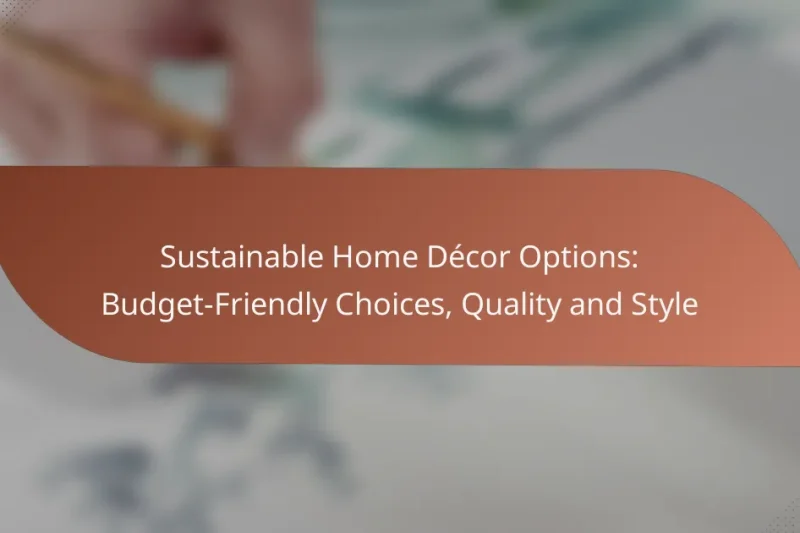Eco-friendly materials are essential for creating home decor that is both stylish and sustainable. By incorporating … Eco-Friendly Materials: Selection, Impact and AestheticRead more
Sustainable Practices in Home Décor
Sustainable practices in home décor focus on using eco-friendly materials and ethical production methods to create beautiful living spaces. By selecting renewable and often recycled resources, homeowners can reduce their environmental impact while enhancing indoor air quality. Embracing these practices not only fosters a healthier home but also supports a broader commitment to environmental conservation.
Sustainable Home Décor Certifications: Standards, Importance and Recognition
Sustainable home décor certifications are essential standards that verify products meet environmental and health criteria, guiding … Sustainable Home Décor Certifications: Standards, Importance and RecognitionRead more
Sustainable Home Décor Aesthetic: Design Principles, Materials and Inspiration
Creating a sustainable home décor aesthetic involves integrating environmentally friendly materials and energy-efficient designs to cultivate … Sustainable Home Décor Aesthetic: Design Principles, Materials and InspirationRead more
Sustainable Practices: Pricing Impact, Value and Consumer Perception
Sustainable practices in e-commerce often result in higher prices due to the costs associated with eco-friendly … Sustainable Practices: Pricing Impact, Value and Consumer PerceptionRead more
Sustainable Home Décor Options: Budget-Friendly Choices, Quality and Style
Exploring budget-friendly sustainable home décor options allows you to create a stylish and eco-conscious living space … Sustainable Home Décor Options: Budget-Friendly Choices, Quality and StyleRead more
Sustainable Artisan Home Décor: Benefits, Quality and Community Support
Sustainable artisan home décor not only enhances your living space with unique, handcrafted items but also … Sustainable Artisan Home Décor: Benefits, Quality and Community SupportRead more
Upcycling in Artisan Home Décor: Techniques, Benefits and Creative Ideas
Upcycling in artisan home décor involves creatively transforming discarded materials into unique pieces that showcase personal … Upcycling in Artisan Home Décor: Techniques, Benefits and Creative IdeasRead more
How can I incorporate sustainable materials in home décor?
Incorporating sustainable materials in home décor involves selecting items that are eco-friendly, renewable, and often made from recycled or organic resources. This not only reduces environmental impact but also promotes healthier living spaces.
Bamboo furniture
Bamboo is a highly renewable resource, known for its strength and durability. When choosing bamboo furniture, look for products that are certified by organizations like the Forest Stewardship Council (FSC) to ensure sustainable sourcing.
Consider pieces such as chairs, tables, and shelving made from bamboo, as they can add a modern aesthetic while being environmentally friendly. Bamboo furniture is often lightweight and easy to maintain, making it a practical choice for many homes.
Recycled glass decor
Recycled glass decor includes items made from repurposed glass, such as vases, light fixtures, and decorative accents. This type of decor reduces waste and minimizes the need for new materials, which can be energy-intensive to produce.
When selecting recycled glass items, check for certifications that indicate the glass has been processed sustainably. Unique designs often result from the recycling process, adding character to your home while supporting eco-friendly practices.
Organic cotton textiles
Organic cotton textiles are made from cotton grown without synthetic pesticides or fertilizers, making them safer for both the environment and your health. Look for items such as curtains, cushions, and bedding that are certified organic.
These textiles are often softer and more breathable than conventional cotton, providing comfort and style. Additionally, they can be dyed using natural dyes, further enhancing their sustainability credentials.
Eco-friendly paints
Eco-friendly paints are formulated without harmful chemicals, making them safer for indoor air quality. When choosing paint, look for low or zero-VOC (volatile organic compounds) options to minimize emissions.
Brands often provide color samples and information on sustainability practices, so consider testing a few shades before committing. Using eco-friendly paint not only protects your health but also contributes to a greener environment.
Hemp rugs
Hemp rugs are made from the fibers of the hemp plant, which is known for its sustainability and durability. These rugs are biodegradable and require less water and pesticides compared to conventional materials like wool or synthetic fibers.
When selecting a hemp rug, consider its texture and weave, as these can vary widely. Hemp rugs can add a natural, rustic charm to your space while being a responsible choice for eco-conscious consumers.
What are the benefits of sustainable home décor?
Sustainable home décor offers numerous advantages, including a reduced environmental footprint, enhanced indoor air quality, and potential long-term cost savings. By choosing eco-friendly materials and practices, homeowners can create a healthier living space while contributing to environmental conservation.
Reduced environmental impact
Utilizing sustainable home décor minimizes the negative effects on the environment. This can involve selecting materials that are renewable, recycled, or sourced sustainably, such as bamboo, reclaimed wood, or organic textiles. These choices help decrease deforestation, pollution, and waste.
Additionally, sustainable practices often include energy-efficient lighting and appliances, which can further lower energy consumption. For instance, LED lighting not only reduces electricity use but also lasts significantly longer than traditional bulbs, contributing to less waste over time.
Improved indoor air quality
Sustainable home décor can significantly enhance indoor air quality by using non-toxic materials and finishes. Many conventional paints, varnishes, and adhesives release volatile organic compounds (VOCs) that can harm health. Opting for low-VOC or zero-VOC products helps create a safer living environment.
Incorporating natural elements, such as plants, can also improve air quality by filtering toxins and increasing oxygen levels. Plants like spider plants and peace lilies are particularly effective and can thrive indoors with minimal care.
Long-term cost savings
Investing in sustainable home décor may lead to long-term financial benefits. While initial costs for eco-friendly materials can be higher, they often prove more durable and require less maintenance over time. For example, high-quality, sustainably sourced furniture can last decades compared to cheaper alternatives.
Moreover, energy-efficient appliances and fixtures can reduce utility bills significantly. Homeowners may save tens of dollars each month, leading to substantial savings over the lifespan of the products. Additionally, many regions offer incentives or rebates for energy-efficient upgrades, further offsetting costs.
Which brands offer sustainable home décor products?
Several brands are recognized for their commitment to sustainable home décor, focusing on eco-friendly materials and ethical production practices. Notable names include West Elm, IKEA, Pottery Barn, and Made Trade, each offering unique products that prioritize sustainability.
West Elm
West Elm is known for its stylish furniture and home accessories made from sustainably sourced materials. The brand emphasizes fair trade practices and often collaborates with artisans from around the world, ensuring that their products support local economies.
When shopping at West Elm, look for items labeled as “sustainable” or “fair trade.” Their commitment to reducing environmental impact includes using recycled materials and offering a range of organic cotton products.
IKEA
IKEA has made significant strides in sustainability, aiming to use only renewable or recycled materials by 2030. Their product lines include furniture made from sustainable wood and textiles, as well as energy-efficient lighting solutions.
To make eco-friendly choices at IKEA, consider their “IKEA Sustainability Report” which details their initiatives and product sourcing. They also offer a recycling program for old furniture, promoting a circular economy.
Pottery Barn
Pottery Barn focuses on creating high-quality, sustainable home décor with a commitment to responsible sourcing. Their products often feature reclaimed wood and organic materials, reducing waste and environmental impact.
When exploring Pottery Barn’s offerings, check for their “Green” product line, which highlights items made from eco-friendly materials. They also provide information on the sustainability of their manufacturing processes.
Made Trade
Made Trade specializes in ethically sourced and sustainable home décor, featuring products from artisans and small businesses. Their curated selection emphasizes fair labor practices and environmentally friendly materials.
For a truly sustainable shopping experience, explore Made Trade’s filters for eco-friendly certifications and materials. This allows you to easily find products that align with your values, such as those made from recycled or organic components.
How do I choose sustainable home décor items?
Choosing sustainable home décor items involves selecting products that minimize environmental impact while promoting ethical practices. Focus on materials, certifications, and the longevity of items to ensure your choices are both eco-friendly and practical.
Check for certifications
Certifications can help identify sustainable home décor items. Look for labels such as FSC (Forest Stewardship Council) for wood products, GOTS (Global Organic Textile Standard) for textiles, and Energy Star for appliances. These certifications indicate adherence to environmental and social standards.
Be aware that not all certifications are created equal. Research the specific criteria behind each label to ensure they align with your sustainability goals. This diligence can help you avoid greenwashing, where products are falsely marketed as eco-friendly.
Evaluate sourcing practices
Understanding where and how décor items are sourced is crucial for sustainability. Choose products made from locally sourced materials to reduce transportation emissions and support local economies. Additionally, inquire about the manufacturing processes to ensure they are environmentally responsible.
Consider the impact of materials used in production. For example, bamboo is a fast-growing resource that can be a sustainable choice, while plastics derived from petroleum are less favorable. Opt for items that emphasize natural, renewable resources.
Consider durability
Durability is a key factor in sustainable home décor. Items that last longer reduce the need for replacements, ultimately minimizing waste. Look for well-constructed products that can withstand wear and tear, which is often indicated by warranties or customer reviews.
Investing in timeless designs and high-quality materials can lead to a more sustainable home environment. For instance, solid wood furniture tends to outlast particleboard alternatives, making it a better long-term investment. Prioritize items that combine aesthetic appeal with functionality to ensure lasting use.
What are the trends in sustainable home décor?
Sustainable home décor trends focus on environmentally friendly practices that enhance aesthetics while minimizing ecological impact. Key trends include biophilic design, upcycled furniture, and minimalist aesthetics, all of which prioritize natural materials and resource conservation.
Biophilic design
Biophilic design integrates natural elements into home spaces, promoting well-being and a connection to nature. This trend often involves the use of plants, natural light, and organic materials, creating a calming atmosphere. Incorporating features like living walls or large windows can significantly enhance indoor air quality and mood.
To implement biophilic design, consider adding indoor plants, using natural wood finishes, or designing spaces that maximize daylight. Aim for a balance between indoor and outdoor environments to foster a sense of tranquility.
Upcycled furniture
Upcycled furniture involves repurposing old or discarded items into new, functional pieces, reducing waste and resource consumption. This trend not only saves money but also adds unique character to your home. Common upcycling projects include transforming pallets into coffee tables or refurbishing vintage chairs.
When considering upcycled furniture, look for local workshops or online marketplaces that specialize in these items. Ensure the materials used are safe and durable, and don’t hesitate to personalize pieces with paint or new upholstery.
Minimalist aesthetics
Minimalist aesthetics emphasize simplicity and functionality, often featuring a limited color palette and uncluttered spaces. This approach encourages mindful consumption, focusing on quality over quantity. By reducing excess, you create a more serene environment that is easier to maintain.
To adopt a minimalist aesthetic, start by decluttering your space and keeping only essential items. Choose furniture and décor that serve multiple purposes, and opt for neutral colors to create a cohesive look. This trend not only enhances visual appeal but also promotes a more sustainable lifestyle by minimizing waste.
How can I create a sustainable home décor plan?
Creating a sustainable home décor plan involves selecting eco-friendly materials, prioritizing energy efficiency, and incorporating recycled or upcycled items. Focus on reducing waste and choosing products that have a minimal environmental impact.
Choose Eco-Friendly Materials
When selecting materials for your home décor, opt for sustainable options such as bamboo, reclaimed wood, or organic textiles. These materials not only reduce environmental harm but also add unique character to your space.
Consider the lifecycle of the materials you choose. Look for certifications like FSC (Forest Stewardship Council) for wood products or GOTS (Global Organic Textile Standard) for fabrics to ensure they meet sustainability criteria.
Incorporate Energy-Efficient Lighting
Energy-efficient lighting is essential for a sustainable home. Replace traditional bulbs with LED options, which use significantly less energy and last much longer. This shift can lead to lower electricity bills and a reduced carbon footprint.
Additionally, consider natural lighting by maximizing window space and using light-colored curtains. This approach not only enhances your décor but also decreases reliance on artificial lighting during the day.
Utilize Recycled and Upcycled Items
Incorporating recycled and upcycled items into your décor can add a unique touch while promoting sustainability. Look for furniture made from recycled materials or visit thrift stores for second-hand treasures that can be refreshed with a little creativity.
Creating DIY projects from old items is another way to embrace upcycling. For instance, turning wooden pallets into coffee tables or using glass jars as decorative storage can reduce waste and personalize your space.






